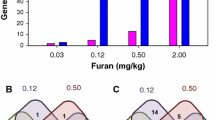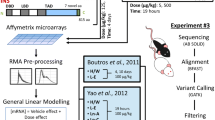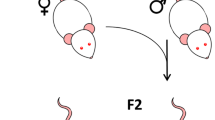Abstract
Studies of gene expression are common in toxicology and provide important clues to mechanistic understanding of adverse effects of chemicals. Most prior studies have been performed in a single strain or cell line; however, gene expression is heavily influenced by the genetic background, and these genotype-expression differences may be key drivers of inter-individual variation in response to chemical toxicity. In this study, we hypothesized that the genetically diverse Collaborative Cross mouse population can be used to gain insight and suggest mechanistic hypotheses for the dose- and genetic background-dependent effects of chemical exposure. This hypothesis was tested using a model liver toxicant trichloroethylene (TCE). Liver transcriptional responses to TCE exposure were evaluated 24 h after dosing. Transcriptomic dose–responses were examined for both TCE and its major oxidative metabolite trichloroacetic acid (TCA). As expected, peroxisome- and fatty acid metabolism-related pathways were among the most dose–responsive enriched pathways in all strains. However, nearly half of the TCE-induced liver transcriptional perturbation was strain-dependent, with abundant evidence of strain/dose interaction, including in the peroxisomal signaling-associated pathways. These effects were highly concordant between the administered TCE dose and liver levels of TCA. Dose–response analysis of gene expression at the pathway level yielded points of departure similar to those derived from the traditional toxicology studies for both non-cancer and cancer effects. Mapping of expression–genotype–dose relationships revealed some significant associations; however, the effects of TCE on gene expression in liver appear to be highly polygenic traits that are challenging to positionally map. This study highlights the usefulness of mouse population-based studies in assessing inter-individual variation in toxicological responses, but cautions that genetic mapping may be challenging because of the complexity in gene exposure–dose relationships.





Similar content being viewed by others
References
Abdo N, Xia M, Brown CC, Kosyk O, Huang R, Sakamuru S, Zhou YH, Jack JR, Gallins P, Xia K, Li Y, Chiu WA, Motsinger-Reif AA, Austin CP, Tice RR, Rusyn I, Wright FA (2015) Population-based in vitro hazard and concentration-response assessment of chemicals: the 1000 genomes high-throughput screening study. Environ Health Perspect 123:458–466
Anders S, Pyl PT, Huber W (2015) HTSeq—a Python framework to work with high-throughput sequencing data. Bioinformatics 31:166–169
Andersen ME, Clewell HJ 3rd, Bermudez E, Willson GA, Thomas RS (2008) Genomic signatures and dose-dependent transitions in nasal epithelial responses to inhaled formaldehyde in the rat. Toxicol Sci 105:368–383
Atienzar FA, Blomme EA, Chen M, Hewitt P, Kenna JG, Labbe G, Moulin F, Pognan F, Roth AB, Suter-Dick L, Ukairo O, Weaver RJ, Will Y, Dambach DM (2016) Key challenges and opportunities associated with the use of in vitro models to detect human DILI: integrated risk assessment and mitigation plans. Biomed Res Int 2016:9737920
Bolger AM, Lohse M, Usadel B (2014) Trimmomatic: a flexible trimmer for Illumina sequence data. Bioinformatics 30:2114–2120
Bradford BU, Lock EF, Kosyk O, Kim S, Uehara T, Harbourt D, DeSimone M, Threadgill DW, Tryndyak V, Pogribny IP, Bleyle L, Koop DR, Rusyn I (2011) Interstrain differences in the liver effects of trichloroethylene in a multistrain panel of inbred mice. Toxicol Sci 120:206–217
Bronley-DeLancey A, McMillan DC, McMillan JM, Jollow DJ, Mohr LC, Hoel DG (2006) Application of cryopreserved human hepatocytes in trichloroethylene risk assessment: relative disposition of chloral hydrate to trichloroacetate and trichloroethanol. Environ Health Perspect 114:1237–1242
Burczynski ME, McMillian M, Ciervo J, Li L, Parker JB, Dunn RT, Hicken S, Farr S, Johnson MD (2000) Toxicogenomics-based discrimination of toxic mechanism in HepG2 human hepatoma cells. Toxicol Sci 58:399–415
Bystrykh L, Weersing E, Dontje B, Sutton S, Pletcher MT, Wiltshire T, Su AI, Vellenga E, Wang J, Manly KF, Lu L, Chesler EJ, Alberts R, Jansen RC, Williams RW, Cooke MP, de Haan G (2005) Uncovering regulatory pathways that affect hematopoietic stem cell function using ‘genetical genomics’. Nat Genet 37:225–232
Chesler EJ, Wang J, Lu L, Qu Y, Manly KF, Williams RW (2003) Genetic correlates of gene expression in recombinant inbred strains: a relational model system to explore neurobehavioral phenotypes. Neuroinformatics 1:343–357
Chiu WA, Ginsberg GL (2011) Development and evaluation of a harmonized physiologically based pharmacokinetic (PBPK) model for perchloroethylene toxicokinetics in mice, rats, and humans. Toxicol Appl Pharmacol 253:203–234
Chiu WA, Rusyn I (2018) Advancing chemical risk assessment decision-making with population variability data: challenges and opportunities. Mamm Genome. https://doi.org/10.1007/s00335-017-9731-6
Chiu WA, Micallef S, Monster AC, Bois FY (2007) Toxicokinetics of inhaled trichloroethylene and tetrachloroethylene in humans at 1 ppm: empirical results and comparisons with previous studies. Toxicol Sci 95:23–36
Chiu WA, Okino MS, Evans MV (2009) Characterizing uncertainty and population variability in the toxicokinetics of trichloroethylene and metabolites in mice, rats, and humans using an updated database, physiologically based pharmacokinetic (PBPK) model, and Bayesian approach. Toxicol Appl Pharmacol 241:36–60
Chiu WA, Campbell JL, Clewell HJ, Zhou YH, Wright FA, Guyton KZ, Rusyn I (2014) Physiologically-based pharmacokinetic (PBPK) modeling of inter-strain variability in trichloroethylene metabolism in the mouse. Environ Health Perspect 122:456–463
Church RJ, Gatti DM, Urban TJ, Long N, Yang X, Shi Q, Eaddy JS, Mosedale M, Ballard S, Churchill GA, Navarro V, Watkins PB, Threadgill DW, Harrill AH (2015) Sensitivity to hepatotoxicity due to epigallocatechin gallate is affected by genetic background in diversity outbred mice. Food Chem Toxicol 76:19–26
Churchill GA, Gatti DM, Munger SC, Svenson KL (2012) The diversity outbred mouse population. Mamm Genome 23:713–718
Cichocki JA, Guyton KZ, Guha N, Chiu WA, Rusyn I, Lash LH (2016) Target organ metabolism, toxicity, and mechanisms of trichloroethylene and perchloroethylene: key similarities, differences, and data gaps. J Pharmacol Exp Ther 359:110–123
Cichocki JA, Furuya S, Venkatratnam A, McDonald TJ, Knap AH, Wade T, Sweet S, Chiu WA, Threadgill DW, Rusyn I (2017) Characterization of variability in toxicokinetics and toxicodynamics of tetrachloroethylene using the collaborative cross mouse population. Environ Health Perspect 125:057006
Crowley JJ, Zhabotynsky V, Sun W, Huang S, Pakatci IK, Kim Y, Wang JR, Morgan AP, Calaway JD, Aylor DL, Yun Z, Bell TA, Buus RJ, Calaway ME, Didion JP, Gooch TJ, Hansen SD, Robinson NN, Shaw GD, Spence JS, Quackenbush CR, Barrick CJ, Nonneman RJ, Kim K, Xenakis J, Xie Y, Valdar W, Lenarcic AB, Wang W, Welsh CE, Fu CP, Zhang Z, Holt J, Guo Z, Threadgill DW, Tarantino LM, Miller DR, Zou F, McMillan L, Sullivan PF, Pardo-Manuel de Villena F (2015) Analyses of allele-specific gene expression in highly divergent mouse crosses identifies pervasive allelic imbalance. Nat Genet 47:353–360
Dennis G Jr, Sherman BT, Hosack DA, Yang J, Gao W, Lane HC, Lempicki RA (2003) DAVID: database for annotation, visualization, and integrated discovery. Genome Biol 4:P3
Domino MM, Pepich BV, Munch DJ, Fair PS, Xie Y (2003) Methd 552.3: determination of haloacetic acids and dalapon in drinking water by liquid-liquid microextraction, derivatization, and gas chromatography with electron capture detection. Office of Ground Water and Drinking Water, Cincinnati
Eduati F, Mangravite LM, Wang T, Tang H, Bare JC, Huang R, Norman T, Kellen M, Menden MP, Yang J, Zhan X, Zhong R, Xiao G, Xia M, Abdo N, Kosyk O, Collaboration N-N-UDT., Friend S, Dearry A, Simeonov A, Tice RR, Rusyn I, Wright FA, Stolovitzky G, Xie Y, Saez-Rodriguez J (2015) Prediction of human population responses to toxic compounds by a collaborative competition. Nat Biotechnol 33:933–940
Evans MV, Chiu WA, Okino MS, Caldwell JC (2009) Development of an updated PBPK model for trichloroethylene and metabolites in mice, and its application to discern the role of oxidative metabolism in TCE-induced hepatomegaly. Toxicol Appl Pharmacol 236:329–340
Farmahin R, Williams A, Kuo B, Chepelev NL, Thomas RS, Barton-Maclaren TS, Curran IH, Nong A, Wade MG, Yauk CL (2017) Recommended approaches in the application of toxicogenomics to derive points of departure for chemical risk assessment. Arch Toxicol 91:2045–2065
Fostel JM (2008) Towards standards for data exchange and integration and their impact on a public database such as CEBS (Chemical Effects in Biological Systems). Toxicol Appl Pharmacol 233:54–62
French JE, Gatti DM, Morgan DL, Kissling GE, Shockley KR, Knudsen GA, Shepard KG, Price HC, King D, Witt KL, Pedersen LC, Munger SC, Svenson KL, Churchill GA (2015) Diversity outbred mice identify population-based exposure thresholds and genetic factors that influence benzene-induced genotoxicity. Environ Health Perspect 123:237–245
Ganter B, Tugendreich S, Pearson CI, Ayanoglu E, Baumhueter S, Bostian KA, Brady L, Browne LJ, Calvin JT, Day GJ, Breckenridge N, Dunlea S, Eynon BP, Furness LM, Ferng J, Fielden MR, Fujimoto SY, Gong L, Hu C, Idury R, Judo MS, Kolaja KL, Lee MD, McSorley C, Minor JM, Nair RV, Natsoulis G, Nguyen P, Nicholson SM, Pham H, Roter AH, Sun D, Tan S, Thode S, Tolley AM, Vladimirova A, Yang J, Zhou Z, Jarnagin K (2005) Development of a large-scale chemogenomics database to improve drug candidate selection and to understand mechanisms of chemical toxicity and action. J Biotechnol 119:219–244
Gatti D, Maki A, Chesler EJ, Kirova R, Kosyk O, Lu L, Manly KF, Williams RW, Perkins A, Langston MA, Threadgill DW, Rusyn I (2007) Genome-level analysis of genetic regulation of liver gene expression networks. Hepatology 46:548–557
Gatti DM, Harrill AH, Wright FA, Threadgill DW, Rusyn I (2009) Replication and narrowing of gene expression quantitative trait loci using inbred mice. Mamm Genome 20:437–446
GTEx Consortium (2013) The genotype-tissue expression (GTEx) project. Nat Genet 45:580–585
GTEx Consortium (2015) Human genomics. The genotype-tissue expression (GTEx) pilot analysis: multitissue gene regulation in humans. Science 348:648–660
Harrill AH, McAllister KA (2017) New rodent population models may inform human health risk assessment and identification of genetic susceptibility to environmental exposures. Environ Health Perspect 125:086002
Harrill AH, Rusyn I (2008) Systems biology and functional genomics approaches for the identification of cellular responses to drug toxicity. Expert Opin Drug Metab Toxicol 4:1379–1389
Harrill AH, Ross PK, Gatti DM, Threadgill DW, Rusyn I (2009a) Population-based discovery of toxicogenomics biomarkers for hepatotoxicity using a laboratory strain diversity panel. Toxicol Sci 110:235–243
Harrill AH, Watkins PB, Su S, Ross PK, Harbourt DE, Stylianou IM, Boorman GA, Russo MW, Sackler RS, Harris SC, Smith PC, Tennant R, Bogue M, Paigen K, Harris C, Contractor T, Wiltshire T, Rusyn I, Threadgill DW (2009b) Mouse population-guided resequencing reveals that variants in CD44 contribute to acetaminophen-induced liver injury in humans. Genome Res 19:1507–1515
Kaeppler SM (1997) Quantitative trait locus mapping using sets of near-isogenic lines: relative power comparisons and technical considerations. Theor Appl Genet 95:384–392
Kim D, Langmead B, Salzberg SL (2015) HISAT: a fast spliced aligner with low memory requirements. Nat Methods 12:357–360
Klaunig JE, Ruch RJ, Lin EL (1989) Effects of trichloroethylene and its metabolites on rodent hepatocyte intercellular communication. Toxicol Appl Pharmacol 99:454–465
Lash LH, Chiu WA, Guyton KZ, Rusyn I (2014) Trichloroethylene biotransformation and its role in mutagenicity, carcinogenicity and target organ toxicity. Mutat Res Rev Mutat Res 762:22–36
Love MI, Huber W, Anders S (2014) Moderated estimation of fold change and dispersion for RNA-seq data with DESeq2. Genome Biol 15:550
Luo YS, Furuya S, Chiu W, Rusyn I (2018) Characterization of inter-tissue and inter-strain variability of TCE glutathione conjugation metabolites DCVG, DCVC, and NAcDCVC in the mouse. J Toxicol Environ Health A 81:37–52
Maloney EK, Waxman DJ (1999) Trans-activation of PPARalpha and PPARgamma by structurally diverse environmental chemicals. Toxicol Appl Pharmacol 161:209–218
Mosedale M, Kim Y, Brock WJ, Roth SE, Wiltshire T, Eaddy JS, Keele GR, Corty RW, Xie Y, Valdar W, Watkins PB (2017) Candidate risk factors and mechanisms for tolvaptan-induced liver injury are identified using a collaborative cross approach. Toxicol Sci 156:438–454
Rakhshandehroo M, Knoch B, Muller M, Kersten S (2010) Peroxisome proliferator-activated receptor alpha target genes. PPAR Res 2010:612089
Rusyn I, Gatti DM, Wiltshire T, Kleeberger SR, Threadgill DW (2010) Toxicogenetics: population-based testing of drug and chemical safety in mouse models. Pharmacogenomics 11:1127–1136
Rusyn I, Chiu WA, Lash LH, Kromhout H, Hansen J, Guyton KZ (2014) Trichloroethylene: mechanistic, epidemiologic and other supporting evidence of carcinogenic hazard. Pharmacol Ther 141:55–68
Sauer UG, Deferme L, Gribaldo L, Hackermuller J, Tralau T, van Ravenzwaay B, Yauk C, Poole A, Tong W, Gant TW (2017) The challenge of the application of ‘omics technologies in chemicals risk assessment: background and outlook. Regul Toxicol Pharmacol 91(Suppl 1):S14–S26
Schadt EE, Monks SA, Drake TA, Lusis AJ, Che N, Colinayo V, Ruff TG, Milligan SB, Lamb JR, Cavet G, Linsley PS, Mao M, Stoughton RB, Friend SH (2003) Genetics of gene expression surveyed in maize, mouse and man. Nature 422:297–302
Schadt EE, Molony C, Chudin E, Hao K, Yang X, Lum PY, Kasarskis A, Zhang B, Wang S, Suver C, Zhu J, Millstein J, Sieberts S, Lamb J, GuhaThakurta D, Derry J, Storey JD, Avila-Campillo I, Kruger MJ, Johnson JM, Rohl CA, van Nas A, Mehrabian M, Drake TA, Lusis AJ, Smith RC, Guengerich FP, Strom SC, Schuetz E, Rushmore TH, Ulrich R (2008) Mapping the genetic architecture of gene expression in human liver. PLoS Biol 6:e107
The International HapMap Consortium (2003) The international HapMap project. Nature 426:789–796
Thomas RS, Allen BC, Nong A, Yang L, Bermudez E, Clewell HJ III, Andersen ME (2007) A method to integrate benchmark dose estimates with genomic data to assess the functional effects of chemical exposure. Toxicol Sci 98:240–248
Thomas RS, Clewell HJ, Allen BC, Wesselkamper SC, Wang NC, Lambert JC, Hess-Wilson JK, Zhao QJ, Andersen ME (2011) Application of transcriptional benchmark dose values in quantitative cancer and noncancer risk assessment. Toxicol Sci 120:194–205
Thomas RS, Philbert MA, Auerbach SS, Wetmore BA, Devito MJ, Cote I, Rowlands JC, Whelan MP, Hays SM, Andersen ME, Meek ME, Reiter LW, Lambert JC, Clewell HJ 3rd, Stephens ML, Zhao QJ, Wesselkamper SC, Flowers L, Carney EW, Pastoor TP, Petersen DD, Yauk CL, Nong A (2013a) Incorporating new technologies into toxicity testing and risk assessment: moving from 21st century vision to a data-driven framework. Toxicol Sci 136:4–18
Thomas RS, Wesselkamper SC, Wang NC, Zhao QJ, Petersen DD, Lambert JC, Cote I, Yang L, Healy E, Black MB, Clewell HJ 3rd, Allen BC, Andersen ME (2013b) Temporal concordance between apical and transcriptional points of departure for chemical risk assessment. Toxicol Sci 134:180–194
Threadgill DW, Miller DR, Churchill GA, de Villena FPM (2011) The collaborative cross: a recombinant inbred mouse population for the systems genetic era. ILAR J 52:24–31
U.S. EPA (2011a) Toxicological review of tetrachloroethylene (CAS No. 127-18-4): in support of summary information on the integrated risk information system (IRIS). U.S. Environmental Protection Agency, Washington, DC
U.S. EPA (2011b) Toxicological review of trichloroethylene (CAS No. 79-01-6): in support of summary information on the integrated risk information system (IRIS). U.S. Environmental Protection Agency, Washington, DC
Uehara T, Ono A, Maruyama T, Kato I, Yamada H, Ohno Y, Urushidani T (2010) The Japanese toxicogenomics project: application of toxicogenomics. Mol Nutr Food Res 54:218–227
Venkatratnam A, Furuya S, Kosyk O, Gold A, Bodnar W, Konganti K, Threadgill DW, Gillespie KM, Aylor DL, Wright FA, Chiu WA, Rusyn I (2017) Collaborative cross mouse population enables refinements to characterization of the variability in toxicokinetics of trichloroethylene and provides genetic evidence for the role of PPAR pathway in its oxidative metabolism. Toxicol Sci 158:48–62
Xu J, Thakkar S, Gong B, Tong W (2016) The FDA’s experience with emerging genomics technologies-past, present, and future. AAPS J 18:814–818
Yang L, Allen BC, Thomas RS (2007) BMDExpress: a software tool for the benchmark dose analyses of genomic data. BMC Genom 8:387
Zeise L, Bois FY, Chiu WA, Hattis D, Rusyn I, Guyton KZ (2013) Addressing human variability in next-generation human health risk assessments of environmental chemicals. Environ Health Perspect 121:23–31
Zhou YH, Cichocki JA, Soldatow VY, Scholl EH, Gallins PJ, Jima D, Yoo HS, Chiu WA, Wright FA, Rusyn I (2017) Comparative dose-response analysis of liver and kidney transcriptomic effects of trichloroethylene and tetrachloroethylene in B6C3F1 mouse. Toxicol Sci 160:95–110
Acknowledgements
This work was supported, in part, by a cooperative agreement (STAR RD83561202) from U.S. EPA to Texas A&M University, a Barry Goldwater scholarship, and grants from the National Institutes of Health (U01 ES026717, R00 ES021535, P42 ES027704, and P30 ES025128). The views expressed in this article are those of the authors and do not necessarily reflect the views of NIH or policies of EPA.
Author information
Authors and Affiliations
Corresponding author
Ethics declarations
Conflict of interest
On behalf of all authors, the corresponding author states that there are no conflicts of interest.
Electronic supplementary material
Below is the link to the electronic supplementary material.
Rights and permissions
About this article
Cite this article
Venkatratnam, A., House, J.S., Konganti, K. et al. Population-based dose–response analysis of liver transcriptional response to trichloroethylene in mouse. Mamm Genome 29, 168–181 (2018). https://doi.org/10.1007/s00335-018-9734-y
Received:
Accepted:
Published:
Issue Date:
DOI: https://doi.org/10.1007/s00335-018-9734-y




